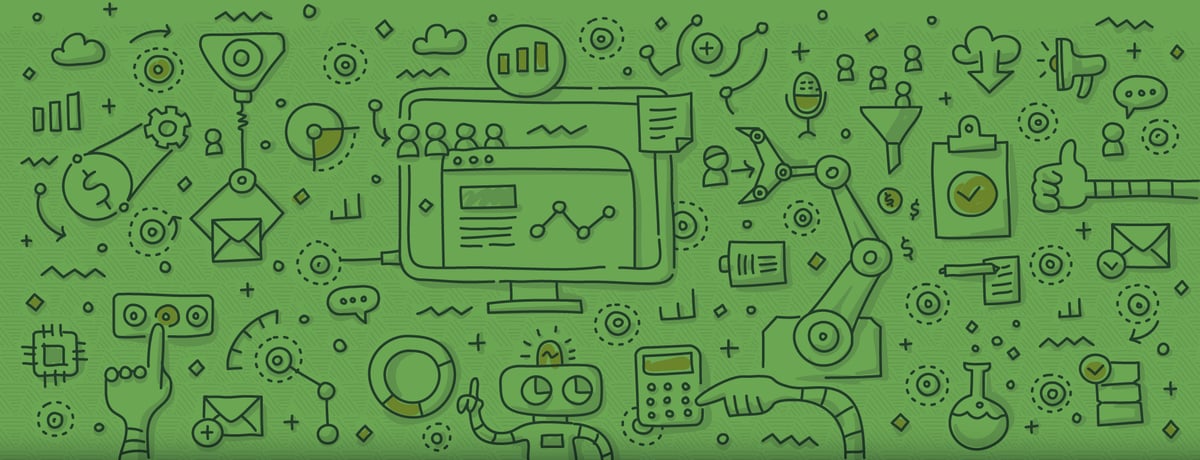
Are you getting the most out of your marketing automation? Many small and mid-sized businesses aren’t. Even if you’ve already had positive results with marketing automation, there’s likely more you could be doing. In comes our marketing automation best practices to the rescue.
In the old marketing model, a few large campaigns were laboriously crafted, used only once to target a broad audience, and evaluated after-the-fact. This process was especially cumbersome for small businesses, who need to move fast to compete. With marketing automation, this process can be multiplied, atomized and continuously improved. Instead of one big marketing cycle, marketing automation software makes it possible to carry out numerous “mini-cycles” simultaneously. This means that if you’re not regularly updating your best practices, you could be falling behind.
We’ve put together this quick, comprehensive guide to marketing automation best practices, to get you on the right track.
Gather Your Research
Go beyond internal data sources to learn about your audience
To get the most out of your marketing automation, you shouldn’t only rely on internal channels to learn about your audience. Your inbound leads, responses and website visitors are only your starting place. Consider using an information management service to gather demographic and personal profiles of your targets. And don’t leave out social media, where your targets are sharing personal updates about what matters to them, and spending a great deal of their online hours.
Summarize what you know so you can see what’s really important
As you gather research, it becomes clear that finding information is the easy part. It’s distilling all that information down to what matters that’s tricky. Luckily, you can use automation to see patterns of behavior in your leads and filter out the extra noise.
For instance, rather than reading every social media post out there from your target audience, use automation to see which networks they use, how often, and what time of day. You can also see what they’re talking about on a regular basis, so you know which topics really matter to them. Worry less about catching every tiny detail, and more about building a comprehensive sketch of each lead category.
Learn and improve in real time
One of the benefits of automation, is you can learn and adapt faster than ever. Perform continuous tests to make sure you’re incorporating new information into your strategy as it arises, and using it engage your leads in time-sensitive ways. This could include event-triggered messaging, or moving a lead to a different product funnel the moment their needs change, so you’re catching them when their interest is at its highest.
Craft Your Campaign
Map your message
The great thing about marketing automation is the potential for personalization. Marketing campaigns can be tailored to each audience, no matter how small. This means crafting your campaign to grow and evolve with your leads, instead of keeping your content static.
Think of lead-nurturing like a map, where you’re steering each lead on just the right path based on how they interact with you.
Build templates to make automation a breeze
Make sure to balance all this personalization with a consistent message and unified aesthetic. Since automation makes it possible to reach your audience through myriad different channels, you want to make sure your brand resonates across each channel.
Templates are key to keeping this balance between personalization and unity. In the age of dynamic email, they’ll also save you work in the long run. Great templates can be reworked and recycled for future campaigns. A good template means more than just inserting a first-name tag here and there; it makes space for personalized recommendations and advice. With strong templates, your leads will easily recognize your message when they see it on different channels as well, including social media or mobile platforms.
Design for your existing customers, not just new leads
Don’t ignore your current customer base on your marketing efforts. This is where marketing automation can really shine, because existing customers have already provided you with lots of useful information that automation tools can utilize. The more you know about a customer, the more you can predict about what they’ll want from you in the future.
Make Your Campaign Come to Life
Share, adapt, and recycle what works
Marketing automation best practices make it possible to take a more modular approach to each campaign. Instead of planning one giant campaign from scratch, you can quickly adapt messages and techniques that have worked before to new leads, and even new campaigns. This means you can craft many small, specific campaigns at once, while ensuring that your message and policies are consistent.
Keep your campaign personalized and dynamic
Remember those “Choose your own adventure” books from the 80’s? Marketing automation means each lead can now choose their own adventure, ie, they can choose what kind of campaign and marketing works for them.
Focus on action-triggered templates, so each interaction with your brand is captured, and triggers a new personalized twist in how you nurture that lead. This includes up-sells and client retention. Good marketing automation software can implement these types of dynamic task-flows.
Keep Testing and Improving Your Approach
Segment scientifically, with predictive model scores instead of manual segmentation.
With marketing automation best practices, you should be segmenting using statistical analysis, and predictive models, as much as possible. It’s less labor-intensive than manual segmentation, but also has been shown to be more accurate. For example, you can use these statistics to predict when a small business that’s in your target group is most likely to need an upgrade in their products.
With the time your marketing team saves by automating segmentation, they’ll be able to create more segments and revise them more frequently, so your marketing gets smarter, faster.
Update your lead scoring, and lead attribution
Lead scoring and attribution used to be simple. But the old approach to lead scoring, and lead attribution, doesn’t tell the whole story.
You can use the data that your automation software collects to make your lead scores more accurate, so you can see not just how much revenue a lead is likely to bring, but how profitable they’ll be. A lower-revenue lead can actually be more profitable if they require less labour to nurture and retain, which can teach you about which leads are more lucrative in the long run.
It’s even more important to take a smart, automated approach to lead attribution, now that most leads are simultaneously being nurtured through multiple channels. Marketing automation can factor in each channel, weighing attribution scores not just for initial contacts, but also for impressions and interactions through multiple channels.
Marketing doesn’t end when sales begin
Instead of the old approach, where the marketing team turns “qualified” leads over to sales and forgets about them, automated marketing best practices should include plenty of back-and-forth between marketing and sales. Personalized, automated marketing should continue and evolve into the sales stage, and beyond. Make sure there’s plenty of volleying and cooperation between your marketing strategy, and your sales strategy.
Ask us anything about digital strategy
Overwhelmed? Don’t be! The right team can give your marketing automation best practices a complete makeover, or facilitate surgical improvements to your approach. Contact Demodia today to take your marketing automation best practices to the next level.


